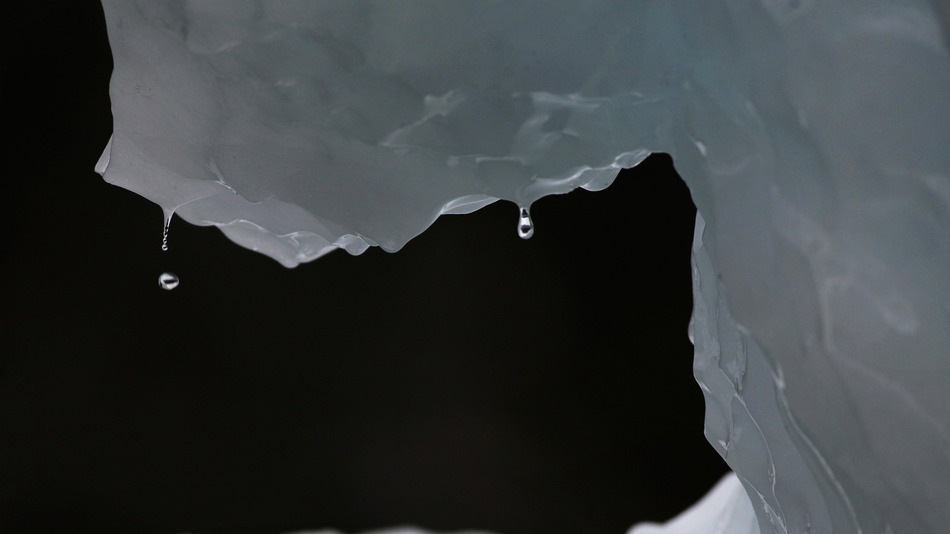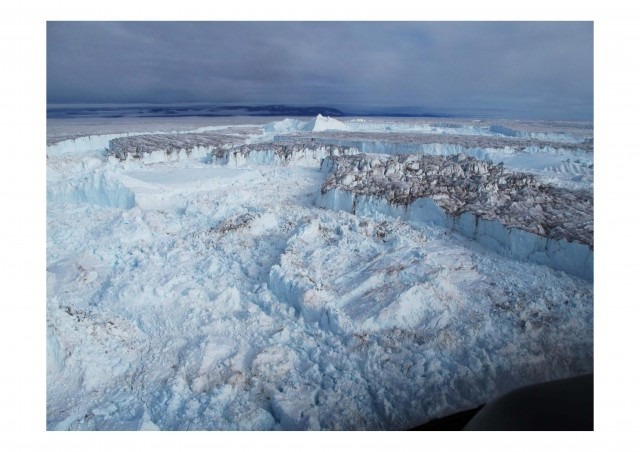Three glaciers holding back a vast ice stream in northeast Greenland, a region thought to be the last bastion of stability in that rapidly warming region, are now thinning and moving more rapidly into the sea, a new study found.
The study overturns longstanding assumptions that the northeastern corner of Greenland, which is one of the coldest and driest parts of the world’s largest island, is stable, and instead suggests that sea level rise projections based on this assumption will need to be reevaluated.
The study, by an international group of researchers from Denmark, the Netherlands, the U.S. and China, found that regional warming has likely caused three outlet glaciers bordering Fram Strait and the Nordic Sea in far northeast Greenland, to lose mass in recent years, matching similar observed trends in the southwest, west and northwest of Greenland. One of the outlet glaciers, in fact, has receded 12.4 miles in just the past 10 years.
Study coauthor Shfaqat A. Khan of the Technical University of Denmark told Mashable he was surprised to find such significant ice loss in northeast Greenland, considering how cold and dry that region is. Previous studies of sea level rise had not included the prospect of melting there, he said.
Major outlet glaciers in northeast Greenland disintegration into the ocean.
Image: Finn Bo Madsen
“Nature is changing faster than expected and seems to respond much stronger than expected to small fluctuations,” he said. “This also means that predictions of future sea level rise need to be revised.”
More worrisome, Khan and his coauthors said, is that these glaciers help hold back a nearly 370-mile long ice stream that extends deep into Greenland’s interior. This ice stream accounts for about 16% of the total ice sheet, and if it destabilizes, it could have severe consequences for low-lying coastal cities worldwide.
Greenland is the world's largest island, extending more than 1,200 miles from its southern to northernmost points, and if all of its ice were to melt — which would likely take many centuries, if not thousands of years — the oceans would rise by more than 20 feet. Already, the melting of the Greenland ice sheet is one of the largest contributors to global sea level rise, accounting for about .02 inches of the .13 inches per year global average sea level rise (local rates of sea level rise vary significantly).
Scientists trying to predict how much sea level rise the world will see in the next several decades have had to grapple with uncertainties about the stability of Greenland as well as portions of Antarctica, and this new study adds to the evidence showing that sea level rise may be more likely to be on the higher end of the scale rather than the lower end.
The most recent report from the U.N. Intergovernmental Panel on Climate Change (IPCC) found that global average sea level is likely to increase by 10.2 to 32 inches by the year 2100, with a highest emissions scenario showing a sea level rise of between 21 and 38 inches by the end of the century if greenhouse gas emissions continue to rise unabated.
Massive calving event seen on the Ilulissat Glacier in western Greenland in 2008, as shown in the film "Chasing Ice."
The new study, published Sunday in the journal Nature Climate Change, found that the northeast Greenland ice stream has been “relatively stable" since at least the mid-to-late 1970s, with a period of rapid dynamic thinning beginning sometime between 2003 and 2006, and continuing through 2013. The researchers traced this to a change in the movement of the ice stream’s three main outlet glaciers: one known as "79 North," as well as the Zachariae Isstrom Glacier, and the Storstrommen Glacier.
These glaciers had been restrained by pack ice that stayed close to shore year-round, but regional warming in recent years has reduced this ice cover.
This has had the effect of removing the parking brake on these glaciers, allowing them to start sliding faster toward the sea. In addition, the intrusion of relatively warm ocean waters may have also played a role, since when they come in contact with the bases of outlet glaciers, they can erode the ice from below, causing increased melting.
Jonathan Bamber, a professor at the University of Bristol who is a coauthor of the study, told Mashable that the researchers aren’t entirely sure what caused the outlet glaciers in northeast Greenland to speed up their melt rate, but they suspect that a warm period between 2003 and 2006 played a role. However, even with a return to lower temperatures since, the ice has continued melting at an increased rate of more than 10 gigatons per year, which suggests this trend is likely to continue, he said. (One gigaton is equal to 1 billion tons.)

Map of Greenland showing the northeast Greenland ice stream (denoted as NEGIS).
Image: Michael Bevis/Nature Climate Change
One concern scientists have is that if the outlet glaciers along the coastline, which make contact with the ocean waters, lose more ice, they may allow the far larger mass of land-based ice behind them to make a push toward the sea.
“This is the first time anyone has ever observed a sudden acceleration of ice loss in the downhill (outlet) portions of a really long ice stream. So, we are in terra incognita,” said study coauthor Michael Bevis of Ohio State University, in an interview with Mashable.
Khan told Mashable that the northeast Greenland ice stream may be destined for the same fate as the more famous Jakobshavn glacier in southwest Greenland, which has been thinning and retreating for more than a decade, at an increasing rate of about 30 gigatons per year.
Additionally, Khan said northeast Greenland has a similar downward-sloping topography to Jakobshavn where the ice meets the bedrock and sea floor, and, since the ice stream extends so far inland, the northeast ice stream constitutes a bigger risk than Jakobshavn does for contributing to sea level rise.
“Ice loss will continue and likely increase like Jakobshavn. Furthermore, the northeast drainage area is twice that of Jakobshavn. Thus, here we have a giant which could be Greenland’s largest contributor to sea level rise in [a] few years,” Khan said in an email conversation.
To gain insight into the ice mass trends of northeastern Greenland, the researchers combined multiple readings of elevation data from aircraft overflights, several satellite sensors and even digital photographs of the area taken beginning in 1976. They also used GPS devices mounted on the bedrock of Greenland to measure any changes in the weight of the ice sheet. This data all showed a clear acceleration in ice loss in the northeast Greenland ice stream.
According to the study, the loss rate of the northeast Greenland ice stream is more than 10 gigatons per year as measured between April 2006 and April 2012. This is similar to the loss rate seen at the Jakobshavn Isbrae glacier.
However, melting of the northeast Greenland ice stream is a more recent development compared to the mass loss of the Jakobshavn Isbrae glacier, Bevin says, and there is a chance that the northeast Greenland ice stream will temporarily slow down or pause its melting altogether for a time due to natural climate variability.
“The pace of change is not even,” he said. “It’s certainly possible it will go down for a while, but chances are [that] it will go up again.”
Even with natural variability, though, Bevin says the long-term trend is clear. “We have no reason to believe that either the air warming or the ocean warming is going to stop, so it would be kind of irrational to assume that the rate of melt in Greenland is going to stop too,” he said.
The Greenland ice sheet as a whole has been melting at an increasing rate during the past decade as warming has increased. Bevis, who worked on the GPS data network that helped confirm the northeast Greenland ice loss trends, says Greenland's mass loss nearly tripled since 2002.
“The instability of Greenland is growing," says Bevis.
As Greenland has warmed by an average of about 3.6 degrees Fahrenheit since the 1980s, the average ice-sheet-wide mass loss increased from about 172.4 gigatons per year from April 2003 through 2006, to 359.8 gigatons per year from April 2009 through 2012, the study found. This increase in melting has raised concerns regarding the potential acceleration in global sea level rise.
The Greenland ice sheet marked a melting milestone in 2012 when surface melting was observed across 97 percent of the ice sheet, including normally frigid high elevation areas in central Greenland.
Correction, 03/17/14 3:37PM
This article has been edited to reflect the following correction:
Global average sea level is rising at .13 inches per year, not 3.3
inches per year, as originally indicated.
http://mashable.com/2014/03/16/greenland-ice-melt-sea-level-rise/

